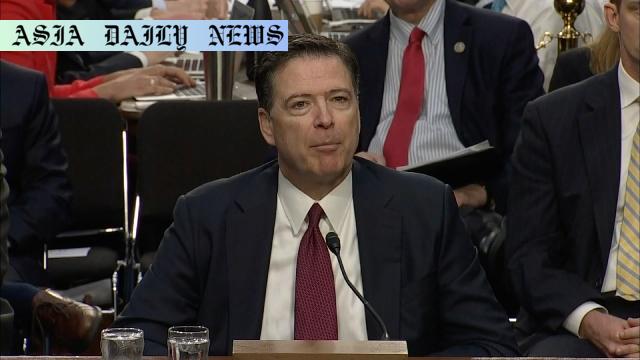Comey questioned by Secret Service over social media post with cryptic ’86 47′ numbers, linked to alleged presidential threat.
Comey posted a photo containing numbers ’86 47′ on social media.
The term ’86’ is slang for dismissing or removing, raising suspicions.
Trump interprets the post as an assassination threat against him.
Comey denies the allegation, emphasizing he opposes all violence.

The Controversial Social Media Post
The recent social media post by former FBI Director James Comey has created a significant stir both within political circles and among the general public. On Thursday, Comey shared a seemingly innocuous photo depicting seashells arranged to form the numbers ’86 47.’ However, the interpretation of these numbers has led to controversy. The phrase ’86,’ in certain slang contexts, refers to dismissing or removing someone, which, when combined with ’47,’ referencing the current U.S. President Donald Trump (the 47th president), raised immediate suspicions. Critics, including Trump and his allies, interpreted the post as an assassination threat against the president.
Response From Authorities and Public Backlash
The implications of this post quickly reached authorities, prompting an investigation. The Department of Homeland Security, led by Secretary Kristi Noem, confirmed that the Secret Service had interviewed Comey regarding the matter. Though no charges have been pressed so far, the incident marks yet another contentious chapter in Comey’s strained relationship with Trump and his supporters. Comey has since removed the post, expressing regret for any unintended interpretations or harm caused. In a public statement, he emphasized, “It never occurred to me, but I oppose violence of any kind, so I took the post down.” Despite his clarification, the debate continues.
Trump’s Reaction and Political Ramifications
President Trump didn’t hold back when asked about the situation. In an interview with Fox News, he accused Comey of posting the image with deliberate intent. “He wasn’t very competent, but he was competent enough to know what that meant,” Trump said, accusing Comey of fostering violent subtext. This reaction adds another layer to their contentious history, stemming from Comey’s dismissal as FBI Director during Trump’s initial term as president. Political analysts argue that this incident may further stoke partisan divisions, with one side scrutinizing Comey’s every move while the other views Trump’s interpretation as far-fetched.
Public Opinion and Broader Implications
The public’s reaction has been polarizing. Supporters of Trump view the incident as another example of the former FBI chief’s supposed bias against Trump. Meanwhile, Comey’s defenders argue that the interpretation of the numbers is a stretch, accusing Trump and his allies of exploiting the situation for political gain. The debate also highlights the broader issue of how messages or symbols are interpreted in today’s hyper-partisan environment. In the age of social media, where context and intent can be easily distorted, seemingly trivial posts can quickly spiral into national controversies.
Lessons Learned and Moving Forward
This incident underscores the importance of thoughtful communication, particularly for public figures. The use of ambiguous symbolism or language risks unintended consequences, as Comey’s post demonstrates. It also serves as a reminder of the high-stakes nature of public discourse, where even an apparently harmless post can ignite political tensions. For Comey, this controversy serves as a cautionary tale about the power and pitfalls of social media. For the public and political community, it reminds us to approach such matters with critical thinking and a willingness to engage in honest dialogue.
Commentary
The Layers of Interpretation in a Polarized Environment
James Comey’s social media post, which featured the numbers ’86 47,’ underscores the challenges of communication in today’s politically charged atmosphere. On the surface, it might seem absurd that a photograph of seashells could spark allegations of threatening behavior. However, in a deeply polarized society, even the simplest gestures are often scrutinized through a political lens. The evocative nature of ’86,’ combined with the reference to the 47th president, fueled interpretations that seem more symbolic than substantive. Regardless of intent, the incident highlights the power of perception and the potential for miscommunication in the digital age.
The Boundaries of Responsibility for Public Figures
Public figures like James Comey carry an added burden of responsibility. Their words, posts, and actions are viewed under a microscope, with potential implications for how they shape narratives or influence public opinion. While Comey insists that no harm was intended, the ambiguity of his post left room for interpretations that could stoke division. It raises pertinent questions about how public figures should navigate the digital realm: Should caution and precision always outweigh personal expression? Or should we, as a society, allow room for human error and nuance?
The Role of Social Media in Political Discourse
This controversy also sheds light on social media’s role as both a platform for connection and a breeding ground for conflict. Posts that lack context can quickly spiral into controversies, as seen here. More importantly, this incident reflects how platforms like Twitter amplify and distort the intent of the original message. In today’s world, where a single post can lead to investigations, the line between personal expression and potential provocation has become thinner than ever. Social media, ultimately, demands thoughtful consideration from both its users and the society interpreting those uses.
Finding Solutions and Navigating Public Discourse
Moving forward, it is essential for both public figures and everyday users to recognize the weight their words carry. This controversy offers a valuable opportunity to reflect on how we communicate and interpret messages. It also stresses the need for fostering a political culture that prioritizes thoughtful discussion over divisiveness. Whether one sees this incident as a genuine concern or an overreaction, it should prompt a broader conversation about the role of social media in shaping our shared reality. Only through active dialogue and awareness can we hope to bridge the divides in our public discourse.


